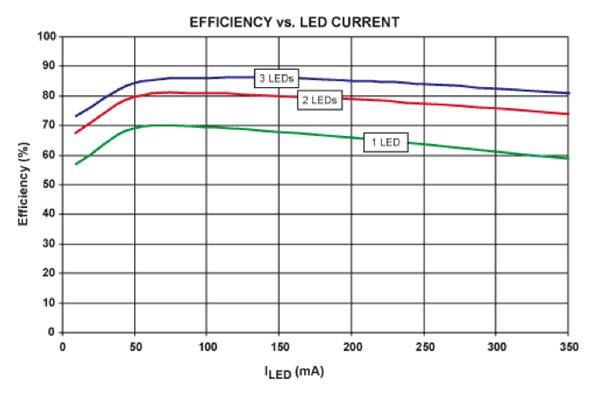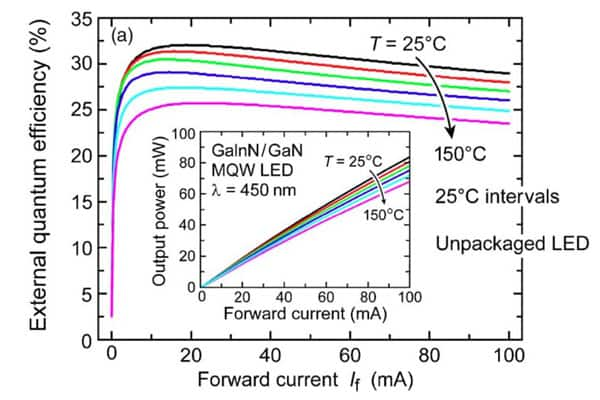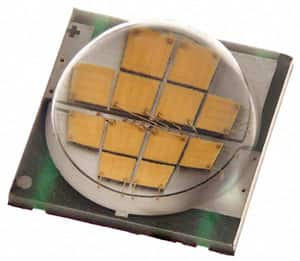Identifying the Causes of LED Efficiency Droop
投稿人:电子产品
2011-10-18
LEDs operate most efficiently at low currents (of just tens of milliamps). As the current increases, efficiency tails off in a phenomenon known as “efficiency droop.” For practical reasons, the LED lighting industry uses drive currents that are much higher than those for which efficiency is optimum. LED manufacturers are keen to address this compromise, but scientists are finding it tough to pin down the cause of the loss of efficiency.
This article takes a look at the effect of efficiency droop on LED performance and describes two popular theories on its origin.
Trading efficiency for light output
For fairly arbitrary reasons, the high-brightness LED industry has settled on a forward current of 350 mA as something of a de facto standard for its products. The reason for this choice primarily revolves around it being the drive current at which a 1 mm² chip typically dissipates 1 W (the actual dissipation is normally closer to 1.25 W).
In the early days of high-brightness LEDs, a forward current of 280 mA was more typical, and today many chips run at higher forward currents than 350 mA. However, neither 280 mA, 350 mA, nor higher currents are anywhere near the most efficient forward current with which to power a high-brightness LED. As efficiency (usually quoted as lumens/watt or lm/W) is something that gets the industry excited, this seems surprising.
A high-brightness LED reaches its peak efficiency at a few tens of milliamps and thereafter, it’s all downhill. Figure 1 illustrates the relationship between efficiency and forward current (ILED) for a single LED (plus a pair and triplet of devices connected in series). For the single device (in this case a Maxim chip), the efficiency peaks at 70 percent at 75 mA, slowly declining to 59 percent at 350 mA.

So why doesn’t the high-brightness LED sector recommend that chips operate at their most efficient point? The reason is that although they run well, LEDs just do not produce enough light at low forward current. The wick has to be turned up much higher to produce a useful output: 350 mA is a good compromise between light output, efficiency, and longevity (increasing the drive current above this level risks raising the junction temperature such that LED lifetime is compromised).
LED manufacturers are working hard to understand the underlying causes of efficiency droop so that they can improve performance at the preferred operating point. While physical limitations will probably prevent efficiency droop being eliminated altogether, if the rate of decline when past the peak can be decreased the problem would be partially mitigated.
Unfortunately, it is proving difficult to determine exactly what’s going on.
Causes of efficiency droop
An early suspicion among scientists investigating the problem was that increased temperature plays a role in efficiency droop. Certainly, elevated junction temperature for LEDs is not a good thing, because it shortens the devices’ lifetime (see the TechZone article “Controlling LED Junction Temperature in Lighting Applications”).
As it turns out, heat is not the culprit. Figure 2 shows the measured external quantum efficiency (EQE) and light output power at different heat sink temperatures as a function of forward current. It can be seen that he EQE at all currents decreases as the temperature rises, and the efficiency droop phenomenon is present at all temperatures. However, the peak efficiency decreases more rapidly at lower temperatures as the current increases (i.e., the slope of the efficiency graph is steeper).
This implies that the magnitude of the droop actually decreases with increasing temperature. The outcome has led scientists to conclude that while an increasing temperature patently decreases the overall efficiency, temperature does not increase–and thus, is not the root cause of–efficiency droop.

Figure 2: External quantum efficiency of GaInN multiple quantum well LED at heat sink temperatures of 25° to 150°C vs current.
We need to look beyond temperature for the source of the problem.
Unfortunately, although temperature has been eliminated, there is no definitive alternative. However, there are two promising theories: Electron leakage and Auger recombination.
Because LED efficiency sits firmly in the realm of quantum physics, the theories aren’t that easy to understand. For example, one recent academic paper¹ states that polarization fields that occur at higher drive currents in the multiple quantum well active region and the electron blockage layer of the LED enhance the leakage of injected electrons into the p-type GaN layer, causing the efficiency droop. In simpler terms, that means physical effects associated with higher currents push electrons out of the recombination zone so they never have the chance to meet with holes and release photons.
In a related theory, others claim the source of efficiency droop involves excess tunneling current reducing carrier injection efficiency.² In other words, many electrons don’t make it to the recombination zone in the first place.
An alternative approach claims the key to understanding efficiency droop is a process called direct Auger recombination. This usually involves electrons and holes recombining and instead of emitting a photon, the energy is transferred to a third carrier. Since the process involves three carriers, the problem would tend to get worse at the high carrier densities common to higher currents lowering efficiency. But calculations reveal this phenomenon can’t account for all of observed efficiency droop.
However, another group of researchers now claims that a combination of direct and indirect Auger recombination does make the sums add up. The process is again complex, and involves electron–phonon coupling and alloy scattering (or Coulomb scattering) by charged defects (phonons are the quantum description of the LED’s crystal lattice vibrations).The electron–phonon coupling is particularly strong in nitride semiconductors. Alloy scattering occurs because the crystal structure of InGaN is not uniform.³ Adding the two forms of Auger recombination together approximates to the experimentally observed efficiency reduction.
Minimizing the droop
In the absence of a definitive answer to the cause of efficiency droop, design engineers need to carefully select their LEDs and operating parameters to minimize its effect. In theory this would mean paying particularly close attention to both the devices’ maximum efficiency and the gradient of the efficiency droop curve beyond that point. The shallower the slope, the less the efficiency will drop off as the forward drive current increases. However, in reality this information is difficult to acquire, as manufacturers tend to focus on a single (lm/W) figure at a particular test current rather than providing information across an entire current range.
Cree, for example, has recently released its XLamp MT-G LED (Figure 3) that features its EasyWhite LED for the high-lumen, small-footprint requirements of 35- and 50-W halogen retrofit lamps. The device incorporates an array of LEDs with a total output of 1265 lm and an efficiency of 75 lm/W at 1.1 A shows the product.

Seoul Semiconductor offers its Z-Power series LEDs that are said to be suitable light sources for general illumination applications, custom designed solutions, and automotive large LCD backlights. The device delivers 100 lm at a forward current of 350 mA, for an efficiency of about 110 lm/W.
Also, Toshiba’s TL19W01 series of high luminous flux white LEDs offer design engineers another alternative for lighting applications. These devices offer 110 lm at a forward current of 350 mA, for an efficiency of 111 lm/W.
Summary
The LED lighting industry uses drive currents that are much higher than those for which efficiency is optimum, so the phenomenon known as efficiency droop is likely to be with us for some time. While LED scientists continue to try to pin down the cause of this loss of efficiency, by carefully selecting LEDs engineers can minimize its effect. Further information can be obtained by using the provided links to DigiKey product pages.
References:
- Min-Ho Kim, “Origin of efficiency droop in GaN-based light-emitting diodes,” Applied Physics Letters 91 183507 (2007).
- Bochkareva, N. I. et al., “Defect-related tunneling mechanism of efficiency droop in III-nitride light-emitting diodes,” Applied Physics Letters 96 133502 (2010).
- Emmanouil Kioupakis et al., “Indirect Auger recombination as a cause of efficiency droop in nitride light-emitting diodes,” Applied Physics Letters 98, 161107 (2011).
免责声明:各个作者和/或论坛参与者在本网站发表的观点、看法和意见不代表 DigiKey 的观点、看法和意见,也不代表 DigiKey 官方政策。






